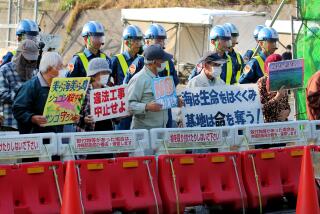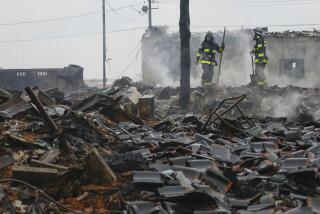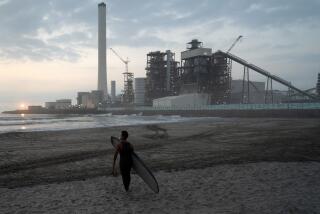Japan’s 2011 earthquake and nuclear disaster still fracturing families
Reporting from KORIYAMA, Japan — When the massive magnitude 9 earthquake rumbled through Fukushima prefecture in March 2011, it swelled the seas and shook the earth. But long after the ground stopped trembling, the disaster has continued to fracture families like that of Yoshinobu Segawa.
With radiation from the crippled Fukushima Daiichi nuclear power plant still a concern, Segawa, 52, a middle school art teacher, and his wife, Yuki, 39, decided that keeping their children in Fukushima was too risky. So they found a new home 140 miles away, in Saitama prefecture.
But Segawa had been employed here for 25 years and switching jobs wouldn’t be easy. To get a position elsewhere, he said, he’d have to take an employment test. “I’m getting old and I’m not sure I would fit in as a teacher in Saitama or Tokyo,” he said, “although I’m good enough for Fukushima.”
So for the last 2½ years, Segawa’s wife and their children — ages 6, 4 and 3 — have been in Saitama. Every other week, Segawa makes the trip to see them. In October, the couple had a fourth child, who was born prematurely. The boy has heart problems that doctors say will require two surgeries.
The couple can’t help but wonder whether being in Fukushima may have some connection. “It doesn’t feel good,” said Segawa, who is on paternity leave until March.
Three and a half years after the Fukushima disaster, many families like the Segawas remain stressed and divided. Other couples have divorced, and suicides related to the nuclear disaster also appear to be on the rise, said Tokyo-based lawyer Kenichiro Kawasaki of the Save Fukushima Children Lawyers’ Network.
Differing values concerning safety frequently lead to marital discord, Kawasaki said.
Tokyo Electric Power Co., or Tepco, which runs the nuclear plant, is in the process of decommissioning the facility, a process expected to last decades. In the current phase, expected to last until 2021, workers are removing fuel debris from the site.
More than 124,000 people remain forcibly displaced because of the Fukushima accident; some have remained nearby, in areas the government considers safe, while others have moved far away. Those required to evacuate receive compensation from Tepco. But families who live outside the mandatory evacuation zone have had to weigh the pros and cons of relocation.
Some couples have decided to stay put because of financial constraints such as mortgages or jobs, or as a result of family commitments such as caring for elderly parents, Kawasaki said.
Like the Segawas, the family of Yasuyuki Taneichi, 49, an orthopedic surgeon in the city of Sukagawa, in Fukushima, has maintained two households.
Taneichi said he hadn’t been able to leave because of the work relationships he’s built there and a responsibility he feels to his patients.
But his wife and three children — in first, sixth and eighth grades — have moved to Ishikawa prefecture on the other side of Japan. Taneichi sees his family every other week.
“I’m paying for housing in two locations and paying about $350 per round trip,” said Taneichi, who is considering leaving Fukushima to be with his family full time.
Naomi Nagasawa, 29, divorced her husband five months after the disaster. “Our divorce isn’t directly connected to the disaster, but our values differed on radiation and we argued a lot,” she said, adding that she had deeper concerns than her spouse did. “I have several acquaintances who have also divorced.”
Now Nagasawa is raising her 4-year-old son, Sora, in an area where radioactivity remains a worry, but she hopes to be able to move away next year. She keeps Sora inside most of the time and has enrolled him in a nursery school that drives youngsters more than 30 miles away to Yamagata prefecture daily to play outdoors.
“I wanted my child to play in nature,” Nagasawa said.
Sora’s teacher, Taeko Henmi, said the transportation costs were covered by private donations and government subsidies.
Just how cautious one should be about outdoor exposure, food, water and other issues is a source of friction among residents of Fukushima these days.
Eiko Watanabe, director of the Fukushima Rinpokan preschool, said she had researched the radiation hot spots around downtown Fukushima City, where her school is located.
“I don’t think you need to go to such extremes,” Watanabe said of driving children 30 miles away to play. “I can understand the anxiety, but it’s being said it should be OK these days and I’d like to believe that.”
A nonprofit group called Three A, in Koriyama, believes it’s better to err on the side of caution. The group orders produce from western Japan and sells it to families who prefer to buy fruits and vegetables grown far away from Fukushima.
Rieko Okabe, 26, is one such mom. She evacuated with her children to Niigata prefecture and stayed there 2½ years, returning to Fukushima recently.
“I worry about produce, but not that many people around me do,” the young mother said, holding bags with okra, asparagus and cucumbers for her two children, ages 5 and 3.
Another organization has donated drinking water from outside the area. Eihito Tsuboi of the nonprofit Fukushima Inochinomizu said the group received enough water for only one-third the number of families who have registered for the free service.
------------
FOR THE RECORD
Nov. 19, 4:02 p.m.: An earlier version of a photo caption with this article was incorrect. The photo is actually of Akie Arakawa, a mother of two, hauling bottled water donated by the nonprofit group Fukushima Inochinomizu.
------------
There is good reason for mothers to be worried about the local water supply, he said, because it is not screened for such radioactive particles as strontium.
One parent taking advantage of Tsuboi’s efforts is Akie Arakawa, 37, mother of 7- and 10 year-olds.
“I don’t want my kids to drink tap water,” she said.
Many residents feel such parents are being overly anxious. Hiroyuki Kobori, manager at a local supermarket, said most locals were worried about radioactive particles in their food immediately after the disaster and didn’t buy local produce. But nowadays, most have returned to buying Fukushima-grown produce, reassured by government testing that has found it to be safe.
“We used to separate local produce from produce we purchased from outside Fukushima,” he said. “Customers seem to care more about freshness and lower prices these days.”
Many experts believe there is still cause for worry.
A 2013 World Health Organization report predicted there would be an uptick of thyroid cancer, breast cancer and leukemia in Fukushima prefecture in coming years.
Masamichi Nishio, honorary director of the Hokkaido Cancer Center, agreed, saying the government has not sufficiently warned the public of possible health effects from exposure to radioactivity.
Toshihide Tsuda, a professor of epidemiology at Okayama University, said cancers could be prevented by limiting exposure time in areas with high radiation rates.
And he strongly agrees with Nishio.
“I find it problematic the Japanese public hasn’t been properly informed by the government to this date because [low levels of radioactive particles] can trigger cancer,” he said.
Nagano is a special correspondent.
More to Read
Sign up for Essential California
The most important California stories and recommendations in your inbox every morning.
You may occasionally receive promotional content from the Los Angeles Times.










